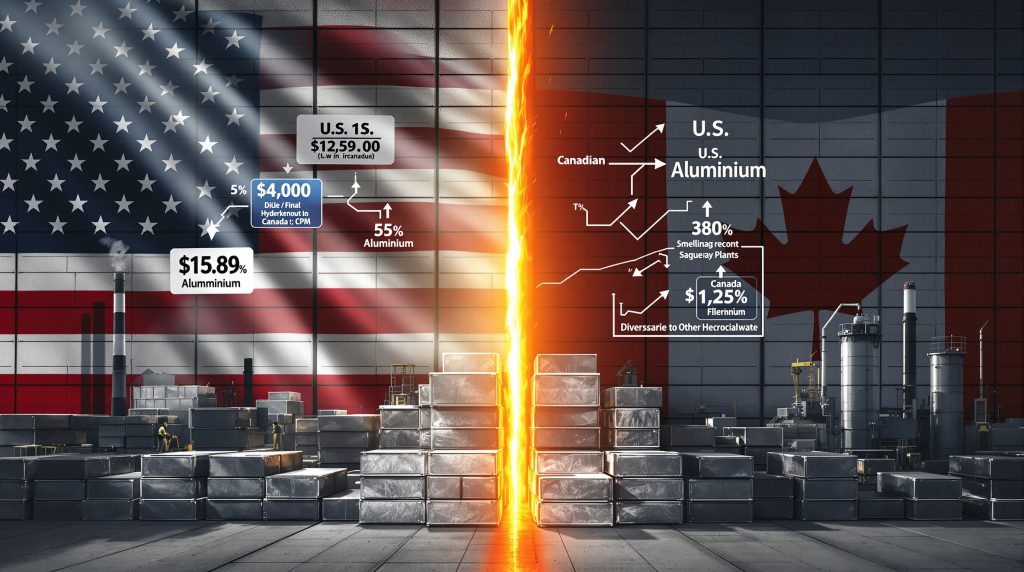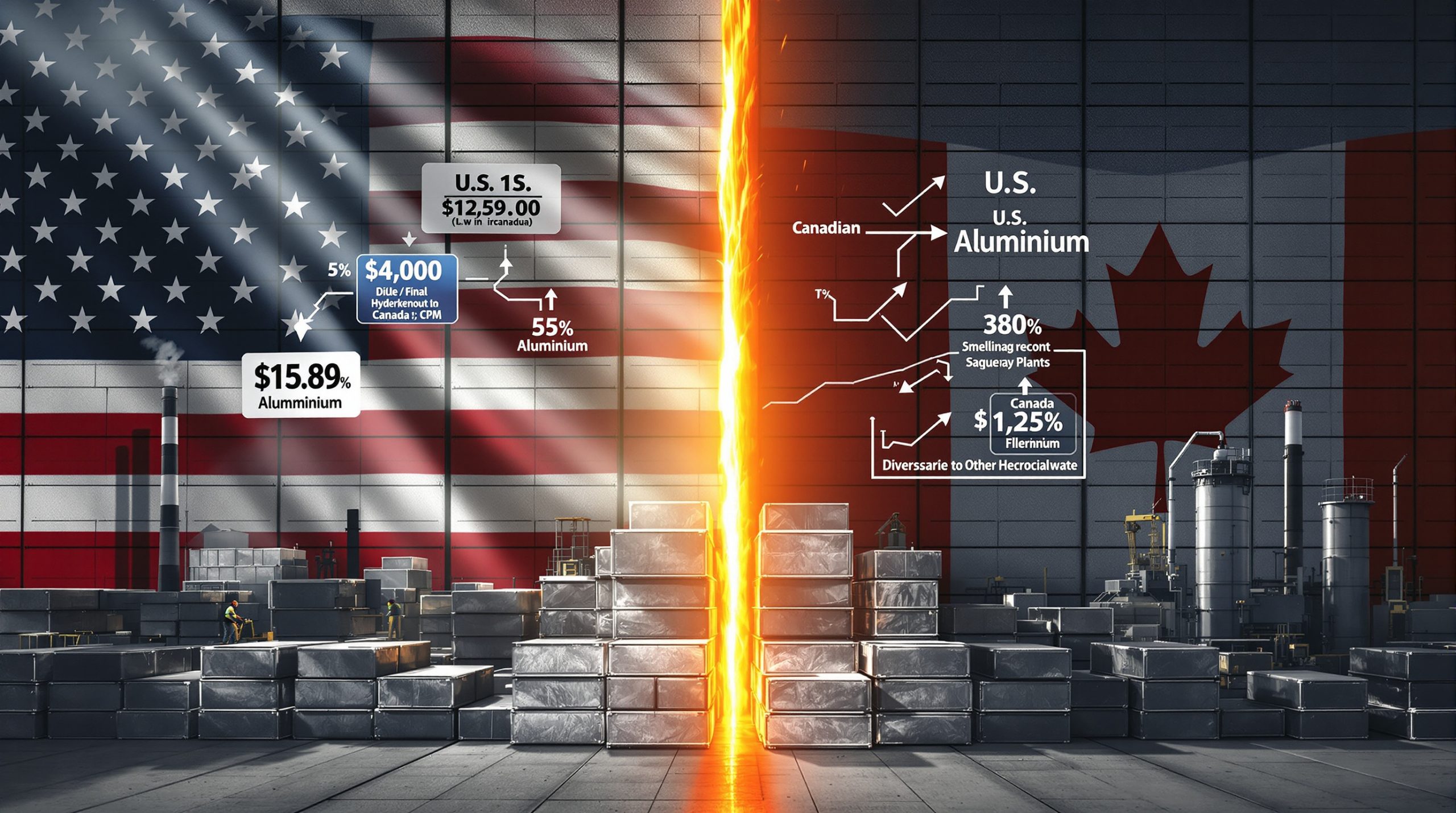The Shifting Dynamics of U.S.-Canada Aluminum Trade Relations
The North American aluminum market is experiencing significant disruption following the implementation of steep tariffs on Canadian aluminum imports. Initially set at 25% in March 2025, these tariffs were doubled to 50% by June 2025, fundamentally altering cross-border metal flows and forcing major industry players to adapt their operations.
The tariffs were implemented under Section 232 of the Trade Expansion Act of 1962, with the U.S. government citing national security concerns. This marked the end of previous exemptions that Canadian aluminum producers had enjoyed since 2018-2019, creating a new reality for the highly integrated North American metals market.
The Economic Impact of Aluminum Tariffs
Since the tariff announcement in early 2025, aluminum prices in the U.S. have risen significantly above international benchmarks. The U.S. Midwest premium—the amount added to global price benchmarks for delivery to that region—jumped 81% since early June alone, creating price disparities that are reshaping trading patterns.
The financial impact on major producers has been substantial. One major producer with Canadian operations reported gross costs of $321 million in the first half of 2025 due to the tariffs impact investment. Another leading aluminum company faced $135 million in costs during the same period from tariffs on their Canadian shipments.
These increased costs are creating ripple effects throughout the supply chain, with downstream manufacturers facing higher input costs and consumers potentially seeing price increases for aluminum-containing products.
Strategic Adaptations by Aluminum Producers
Creative Trading Strategies
In a remarkable strategic shift, some major aluminum producers with Canadian smelting operations have begun purchasing aluminum within the U.S. market rather than importing their own production across the border. This counterintuitive approach has become economically advantageous under the new tariff structure.
One major producer has purchased at least 50,000 tons of aluminum from the U.S. spot market since June 2025, despite having shipped 723,000 tons of aluminum to the U.S. in the year's first half (mostly before the 50% tariffs took effect).
Companies are implementing innovative trading approaches to navigate the tariffs' global trade impact:
- Purchasing aluminum blocks (ingots) on the open U.S. market
- Engaging trading houses and banks to facilitate domestic aluminum transactions
- Sourcing metal from U.S. ports and warehouses to avoid cross-border movements
- Redirecting Canadian production to alternative markets
As commodities trader Darrell Fletcher of Bannockburn Capital Markets noted, "Producers will need to adjust their operations to the extent they can if they're bringing metal in from outside the U.S. You'll have to get creative."
Supply Chain Restructuring
The tariffs on Canadian aluminum have forced companies to completely rethink their North American supply chains. Canadian smelters, which have historically enjoyed competitive advantages due to cheap hydroelectric power (particularly in Quebec's Saguenay region), now face significant barriers to their traditional U.S. market access.
The market has created strange new dynamics where producers are effectively competing against themselves—buying from competitors in the U.S. market rather than using their own production to supply their customers.
Canada's Response to Aluminum Tariffs
Retaliatory Measures
Canada has responded with its own countermeasures to the U.S. tariffs. These retaliatory actions aim to protect Canadian industries and create negotiating leverage in ongoing trade discussions. The Canadian government has announced that while it values the integrated North American market, it will not hesitate to protect its industries from what it considers unfair trade practices.
Impact on Canadian Producers
Canadian aluminum producers, particularly those clustered in Quebec's Saguenay region where hydroelectric power provides a competitive advantage, face significant challenges:
- Contract cancellations from U.S. buyers
- Pressure to find alternative markets for their production
- Strategic reassessment of their North American operations
- Potential production adjustments at Canadian facilities
With five major smelters operating in Quebec province alone, the stakes are high for Canadian aluminum production. These facilities have historically benefited from both abundant renewable energy and easy transportation links to the U.S. market.
The Broader Market Implications
U.S. Aluminum Self-Sufficiency Challenges
The U.S. aluminum industry faces structural limitations in achieving self-sufficiency:
- Only four operating aluminum smelters currently exist in the United States
- Domestic capacity remains insufficient to meet U.S. demand
- New plants face high energy costs and lengthy development timelines
- The country relies on imports for approximately 60% of its aluminum needs
This fundamental supply-demand imbalance means that despite the tariffs, the U.S. will continue to require significant aluminum imports. The question becomes from where this aluminum will be sourced and at what cost.
Global Aluminum Flow Redirections
The tariffs are reshaping global aluminum trade patterns:
- Canadian exports to the U.S. have declined significantly since June 2025
- U.S. buyers are increasingly drawing down domestic inventories
- Alternative suppliers are seeking opportunities in the premium-priced U.S. market
- Global producers are reassessing their international shipping strategies
As Ewa Manthey, commodity strategist at ING Groep NV, observed, "The tariffs are already starting to reshape global aluminum flows, particularly affecting producers in Canada."
Future Outlook for the Aluminum Market
Price Trajectory Predictions
Market analysts suggest that despite the significant increases already seen, U.S. aluminum prices have not yet fully factored in the impact of the 50% tariffs. This indicates potential for further price increases as domestic inventories diminish and the market adjusts to the new trade reality.
The U.S. Midwest premium, which serves as a key indicator of regional pricing dynamics, may continue its upward trajectory as the full effects of the tariffs affecting iron ore and other metals work through the supply chain.
Long-Term Supply Chain Restructuring
The aluminum industry is likely to undergo significant structural changes if the tariffs remain in place long-term:
- Potential expansion of U.S. domestic smelting capacity, though constrained by energy costs
- Development of alternative global supply routes that bypass Canadian production
- Increased vertical integration by downstream manufacturers seeking price stability
- Innovation in aluminum recycling and alternative materials to reduce reliance on primary aluminum
Manufacturing Industry Impact
The tariff situation creates cascading effects throughout manufacturing supply chains:
- Higher input costs for downstream industries using aluminum
- Potential manufacturing relocations to optimize around the new tariff structure
- Reassessment of long-term supply agreements and pricing models
- Increased focus on developing alternative sourcing strategies
Industries particularly vulnerable to these disruptions include automotive manufacturing, aerospace, construction, packaging (especially beverage containers), and consumer electronics.
FAQ: Understanding Aluminum Tariffs and Their Impact
How do aluminum tariffs affect consumer prices?
Aluminum tariffs typically result in higher costs for consumer goods containing aluminum, from beverage cans to automobiles. Manufacturers often pass these increased input costs to consumers, though the exact impact varies by product category and competitive dynamics.
The effect can be most pronounced in products where aluminum represents a significant portion of the total cost, such as beverage packaging or certain automotive components.
Are these tariffs likely to remain in place long-term?
Trade policies remain subject to change based on diplomatic negotiations, economic conditions, and political priorities. The volatile nature of international trade relations suggests that further adjustments to the current tariff structure remain possible.
Historical patterns indicate that tariffs are often used as negotiating tools and may be modified as part of broader trade agreements or diplomatic initiatives.
How important is Canadian aluminum to the U.S. market?
Canada has historically been the largest foreign supplier of aluminum to the United States, accounting for approximately 53% of U.S. aluminum imports over the past year. This high level of integration underscores the significance of the current trade disruption.
The close proximity, established supply chains, and renewable energy advantages have made Canadian aluminum particularly important to the U.S. market.
What industries are most affected by aluminum tariff increases?
Industries with high aluminum usage face the greatest impact, including:
- Automotive manufacturing
- Aerospace
- Construction
- Packaging (especially beverage containers)
- Consumer electronics
These sectors must either absorb higher input costs, pass them on to consumers, or find creative ways to reduce aluminum usage through redesign or material substitution.
Potential Future Scenarios
Diplomatic Resolution
One possible outcome is a negotiated settlement between the U.S. and Canada that results in modified tariffs or exemptions. Historical precedent suggests that trade tensions often lead to eventual compromises that balance competing interests.
Market Adaptation
If tariffs remain in place long-term, the market will likely develop new equilibriums with adjusted supply chains, potentially higher baseline prices, and strategic repositioning by major producers. The current creative trading strategies may become standard practice.
Technological Innovation
Higher aluminum prices could accelerate research into aluminum alternatives, more efficient usage, and enhanced recycling technologies. Price pressures often drive innovation as manufacturers seek to maintain competitiveness.
Conclusion
The tariffs on Canadian aluminum have fundamentally disrupted the North American metals market, creating both challenges and strategic opportunities for industry participants. Companies are demonstrating remarkable adaptability through creative trading strategies and supply chain restructuring.
While the immediate impact includes higher prices and commodities market volatility, the long-term consequences remain uncertain and will depend on factors including diplomatic relations, market responses, and potential technological innovations.
For consumers and downstream industries, the situation underscores the complex interdependencies of global trade and the cascading effects that trade policy decisions can have throughout manufacturing supply chains. Additionally, many analysts are closely watching North American mining trends for indications of how the broader metals sector might evolve in response to these trade barriers.
Want to Catch the Next Big Mineral Discovery Before the Market?
Discovery Alert's proprietary Discovery IQ model provides real-time notifications when significant ASX mineral discoveries are announced, giving you a crucial advantage in the volatile commodities market. Visit our discoveries page to see how historical mineral finds have generated exceptional returns for early investors.




